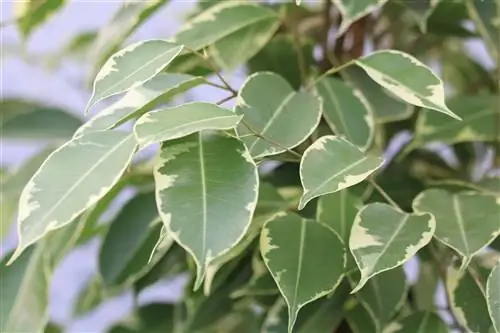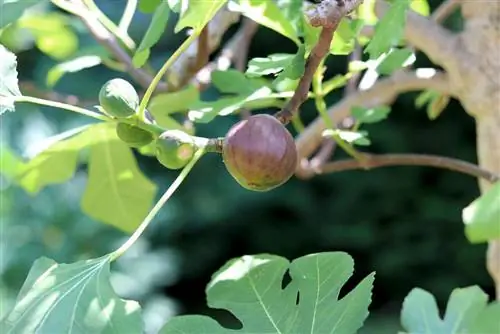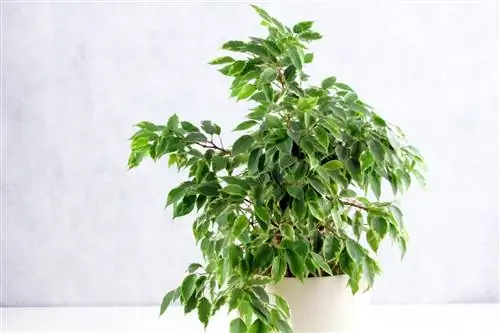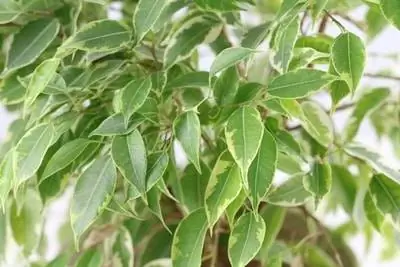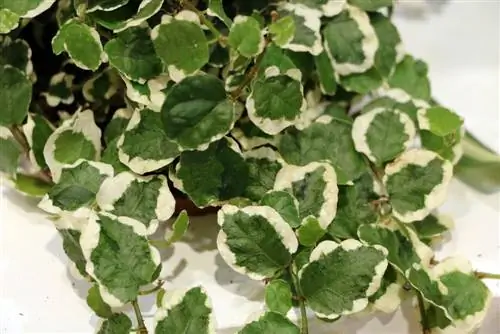- Author admin [email protected].
- Public 2023-12-17 03:39.
- Last modified 2025-01-24 12:45.
The birch fig, botanically Ficus Benjamina, belongs to the mulberry family and is particularly popular in this country as a houseplant. There are different types. The 5 cm to 11 cm long leaves are light green to dark green and smooth and shiny. Younger plants tend to have light green leaves that darken with age. The trunk of the birch fig trunk is smooth and light gray in color. The mulberry plant can grow up to 6 m high.
A location that makes you feel good is important
The plant with the shiny leaves is a bit sensitive and doesn't like to change its place. It likes to be bright, but doesn't want direct sun. If there is no other way to set up your apartment, direct sunlight is best tolerated in the morning. The room temperature should be approximately a constant 20 to 24 degrees. The Ficus Benjamina does not feel comfortable right next to the heating and is prone to pest infestation.
Caring for and fertilizing the birch fig
The birch fig doesn't like pots that are too big. High-quality potting soil should be used that contains only a small amount of peat. You shouldn't overdo the watering, so water a little less and let the soil at the top of the bucket dry out for a few days beforehand. If the birch fig is too moist, it tends to drop its leaves. It can tolerate some complete fertilizer about every 2 weeks, which is added directly to the irrigation water. Complete fertilizer contains all the nutrients and minerals for the ficus in a balanced amount. The rest phase begins in late summer, after which fertilization should largely be stopped. If Ficus Benjamina sheds some leaves in winter, this is completely normal and nothing to worry about. Here again, the plant should not be kept too moist even in the cool season. From spring onwards, fertilization can be carried out again every 14 days. Spraying with low-lime water throughout the year is good for the birch fig. You can tell that it needs a new pot after a few years because the roots have developed strongly and completely fill the space in the planter.
These pests can occur
The attractive Ficus Benjamina is often attacked by pests, especially in the dark winter months. These are usually
- Scale insects
- Spider mites
- Mealybugs
The infestation with scale insects is particularly noticeable on the bark, where light spots can be seen. The bark offers the pests suitable shelter. Scale insects can also be identified by a sticky coating on the leaves.
Mealybugs can be recognized by the white down they spread in the leaf axils and on the underside of the leaves. Spider mites live under a fine white web, mainly on the underside of the leaves, which can sometimes only be seen with a magnifying glass. The tiny arachnids also like to settle in the leaf axils of the Ficus Benjamina. Modern plant protection does not necessarily have to contain poison.
There are commercially available products that can be used to spray the leaves to combat pest infestation. Another option that usually works more effectively are the sticks, which are inserted into the soil of the ficus and release their poison through the roots into the sap stream of the birch fig.
If you don't want to use poisons, you can remove the mealybugs and scale insects manually by carefully scraping them or by spraying them with a non-toxic oil-based agent.
Depending on the type of scale insect, there are natural enemies available from specialist retailers. This could be a certain species of parasitic wasp or a certain ground beetle that has scale insects on its menu. The same applies to spider mites, which can be easily eliminated using beneficial insects.
The pruning of the birch fig
If the birch fig feels comfortable, it will grow taller and wider. This requires pruning at some point. The best time for this is spring and summer. Shoots that have become too long are shortened and branches that are diseased, dry and only lightly covered with leaves are trimmed. It will then be good for the plant if it receives some fertilizer. The cut should definitely be carried out with gloves, as the sap of the Ficus Benjamina is slightly toxic and also irritating to the skin.
Propagation by head cuttings
The attractive houseplant can be propagated using head cuttings. To do this, some of the two-year-old shoots are largely freed of leaves and cut off to a length of 10 to 15 cm. The shoots are planted two feet deep in a nutrient-poor substrate and kept evenly moist until they have formed roots. To ensure that the moisture is distributed evenly, a film is pulled over the pots. The young shoots take root most easily in a bright but not sunny place. The birch fig is an attractive and useful plant. It constantly supplies new oxygen and removes formaldehyde from the room air.
Short care tips
- Ficus loves a bright, sunny location, but drafts must be avoided at all costs.
- If the plant is constantly standing by a tilted window, it will quickly get used to it, but it really shouldn't be like this constant breeze.
- The plant doesn't need much water. The soil should always only be slightly moist. The best method for ficus is the diving method. If the substrate is too dry, place the pot with the plant in a bucket filled with water. As soon as no more air bubbles appear, the substrate is sufficiently saturated with water.
- Drain off the excess water well and the ficus will have enough water for the next 1-2 weeks.
- The ficus only needs fertilizer from April to September. Please do not fertilize in winter and water a little less.
- The ficus also doesn't like it when it has to change location frequently. So after you buy it, think carefully about where you're going to put it and that's where it should stay. Turn a little every now and then so that all sides get enough light, that's enough.
- If you put the tree outside in the summer, you shouldn't be surprised if it behaves like a tree in the fall. Leaf fall is then normal. However, he soon recovers in the room. You should probably have a little patience with him in this case.
- It can be propagated wonderfully through cuttings. Delicate shoots can also be intertwined with each other. It is also not uncommon for two different varieties (1x green, 1x variegated) to be intertwined together. This creates a great picture when the plants get a little bigger.
Ficus Benjaminia requires a bright to partially shaded location. The plant must be protected from direct midday sun. The soil should be medium-heavy and humus-rich. Compost or garden soil and peat in equal parts is well suited, but standard soil usually works too.
Watering should be regular, but not too heavy. The bale must always be kept moderately moist. There is less watering in winter. In between you can let the earth dry out a little. Waterlogging must be avoided at all costs. In summer, the Ficus Benjaminia likes to be sprayed with low-lime water. In summer, fertilization is carried out every 14 days with 0.2% fertilizer. In winter, fertilizer application is reduced to every six weeks.
The plant can be repotted in spring if necessary. The pot shouldn't be too big. If the roots are somewhat restricted, the plant usually becomes bushier and does not shoot up as much. To encourage it to grow bushy, the birch fig can also be cut back in spring. You can also cut a birch fig into a ball shape. You should do this carefully so as not to cut them.
The Ficus Benjaminia can be propagated using head or shoot cuttings in spring. These are inserted directly into the plant substrate. A peat-sand mixture is best suited. The prerequisite for thriving is a temperature of 20 to 25 ºC and high humidity. It's best to put a plastic bag over the pot.
Ficus Benjaminia is susceptible to scale insects, spider mites and thrips.

